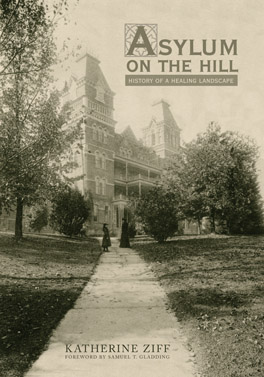Culture
‘Blood, Brains, and Lobotomies’ Coming to SEO History Center April 19
By: Emily Votaw
Posted on:
 A Madness So Discreet is a young adult historical fiction novel set in the late 1800s that follows the story of Grace Mae, a young woman who has been raped by her father, a well-established Boston politician, and unwillingly admitted to an insane asylum. In the book, which was written by Ohio-based author Mindy McGinnis, Grace manages to get out of the inhumane quarters of the Boston asylum she was originally imprisoned in to the Athens Insane Asylum, a humane hospital that still overlooks Athens.
A Madness So Discreet is a young adult historical fiction novel set in the late 1800s that follows the story of Grace Mae, a young woman who has been raped by her father, a well-established Boston politician, and unwillingly admitted to an insane asylum. In the book, which was written by Ohio-based author Mindy McGinnis, Grace manages to get out of the inhumane quarters of the Boston asylum she was originally imprisoned in to the Athens Insane Asylum, a humane hospital that still overlooks Athens.
On Thursday, April 19 at 6 p.m., McGinnis is coming to the Southeast Ohio History Center (24 West State Street, Athens) to give a free presentation entitled “Blood, Brains, and Lobotomies,” which will explore the history of the Athens Insane Asylum (especially as it pertains to McGinnis’ Edgar-Award-wining book,) as well as the history of the treatment of the mentally ill, a subject that McGinnis researched in great deal before writing the book. The presentation is also a part of the history center’s ongoing 2018 celebration of the Athens Asylum’s sesquicentennial anniversary.
McGinnis learned of the Athens Asylum by way of Katherine Ziff’s lauded Asylum on the Hill: the History of a Healing Landscape, which she picked up from Ziff at the Ohioana Book Fair several years ago.
“After I read the book, I knew that I wanted to set a novel there, if I could ever come up with a plot for it,” said McGinnis. “Asylum on the Hill is great, it’s a very thorough history of the asylum that dispels the many misconceptions that people have about the asylum. Those misconceptions, that the asylum is a scary place, or a haunted place, are just good fodder for bad, untrue stories. In fact, the asylum was one of the best places to be if you were mentally impaired in the early 1900s.”
McGinnis was fascinated with the hospital’s moral treatment plan, which meant providing a beautiful, inspiring grounds for patients to work and heal together. The entire asylum, although it may look stark and mysterious on the hillside overlooking the Ohio River, was actually built according to the Kirkbride Plan, which was literally an asylum building plan contingent to some very humane theories in the treatment of the mentally ill: that they needed sources of natural light and ventilation.
“It’s true that the asylum was overcrowded later on, but in the beginning, it was pretty idyllic, patients farmed and made their own clothes and food, it was a completely self-sustaining environment that gave the patients a sense of belonging and purpose, and it was also all free,” said McGinnis. “It was wonderful, but over the years people did start to abuse the asylum, like if you had an elderly relative at home that you just didn’t want to take care of anymore, you’d just drop them up on the hill. Although any asylum could be, of course, horrible, honestly the story of the Athens Asylum is one of the nicest ones you’re going to find.”

McGinnis said that her discovery of Ziff’s book came just as McGinnis was supposed to pitch another novel, so she pursued the idea of a novel set there with more intensity, devouring both The Devil In the White City: Murder, Magic, and Madness and the Fair that Changed America (about American serial killer Dr. H.H. Holmes by Erik Larson) and The Lobotomist: A Maverick Medical Genius and His Tragic Quest to Rid the World of Mental Illness (a biography of Dr. Walter Freeman, who simplified the lobotomy procedure in the ‘50s, and who travelled around the country performing the procedure by Jack El-Hai,). McGinnis read lots of other books about the history of psychiatry, rounding out in about 18 months of research before she had even written a word of A Madness So Discreet.
The history of psychiatry is a notoriously difficult topic. From the discipline’s early struggles to be considered a hard science with the capability to confront some of the most baffling issues of the human condition to the early methods of treatment for the mentally ill that were, at best, ineffective, and at worst, terribly inhumane. Perhaps the most controversial of these methods was the psychosurgery known as the prefrontal lobotomy, which effectively cuts most of the connections to and from the prefrontal cortex in the brain. The prefrontal cortex houses one’s personality, will to live, and general executive function capabilities. Although the procedure is thought of as barbaric now, it should be noted that in 1949 Portuguese neurologist António Egas Moniz won the Nobel Prize in Medicine for the development of the procedure.
Although the surgery did often come at the cost of the patient’s self immediately and permanently vanishing, it was considered a true innovation at the time, and widely utilized until the introduction of the first widely marketed antipsychotic, trazodone, in the ‘60s. Trazodone, and other antipsychotics, work largely the same way on the brain that a lobotomy does, only chemically. Antipsychotics are commonly prescribed to treat everything from schizophrenia to major depression to eating disorders.
“Dr. Freeman had a bad reputation, but he was actually a very good doctor,” said McGinnis. “He really did care about his patients, about the people he lobotomized. He would follow up with his patients for 5, 6, even 20 years after the lobotomy, he really believed he was helping people. We need to remember that, at the time, lobotomies were considered very humane, as the most humane way to treat some people. Of course, you should never do something to someone against their will, as some patients were lobotomized without their permission, but it’s interesting to think that another method of treatment that is sometimes considered inhumane is still used today: electroshock therapy. And it’s still used today because it works, in small doses, much smaller than what they were doing in the ‘50s, and as a last resort for some patients.”
McGinnis ran into a bit of problem while penning A Madness So Discreet, in that for several reasons she needed to set the book in the late 1800s, but the problem being that lobotomies, (a false lobotomy is performed on Grace in the book to make her “unreturnable” to her wealthy, abusive family,) did not actually become a regular, widespread practice until the late 1940s.
Enter Phineas Gage, one of the most famous names in the history of neuroscience.

On September 13, 1848, American railroad construction foreman Phineas Gage was directing a work gang south of Cavendish, Vermont, blasting rock in preparation for a Rutland & Burlington Railroad. Around 4:30 p.m. that day an explosion threw a three-foot-seven-inch, 13.25-pound tamping iron through Gage’s open mouth, destroying his left frontal lobe. Improbably, Gage survived, going on to become one of the most famous cases in the history of neuroscience. Gage experienced some marked personality changes after the accident, which changed the way that scientists of the time understood the importance of the prefrontal cortex.
“I felt like it was very possible that in the late 1800s there might have been a doctor who used Phineas Gage as his touchstone for a procedure that would be a like a lobotomy, even if lobotomies were not widespread quite yet,” said McGinnis.
McGinnis decided on Grace as her protagonist for the book for several reasons, one of them being the fact that it would allow her to explore the injustices done to women at that time in history.
“The truth is that women had very few rights in the late 1800s, and the only think it took for a woman to be sent to an asylum for the rest of her life was for a male family member to recommend it and for a circuit court judge to sign off on it, and they could be easily bribed,” said McGinnis. “During my research I read about one instance where a woman was hospitalized just because her husband had his eye on a younger woman. He already had in his possession all the land that came as a part of his marriage to his wife, and he wanted the younger woman, for one, because she was younger, and for her land, as well. It was a very simple, common thing to bribe a circuit court judge and it was a very simple, common thing for male family members to have ulterior motives in sending their wives or daughters to the asylum.”
McGinnis said that sometimes she is questioned as to why she tackles the troubling topic of rape in her book, which is specifically targeted at younger readers.
“Some people ask me why I had the father be the aggressor in an abusive relationship with his daughter in the book, and the reason is: that’s who it happens to. It happens to young girls and it’s done to them by older male family members,” she McGinnis. “And it’s very important that Grace had some type of enormous trauma in her life as she is a selective mute, which is very important to the plot of the book.”

